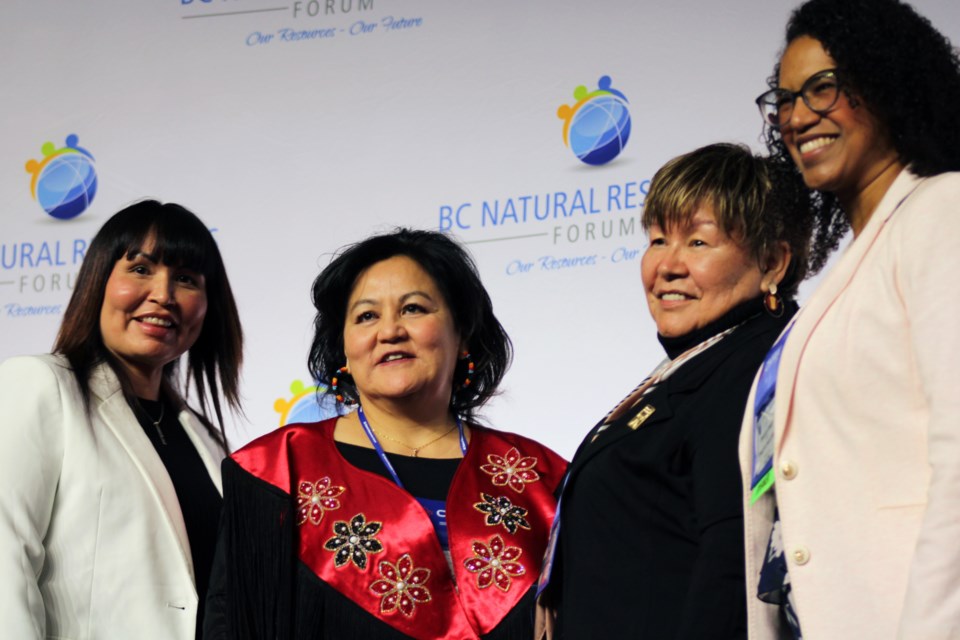The need for more facilities to export liquid natural gas from Canada to Asian markets was never more apparent to Karen Ogen than when she went on a tour of China and saw cities shrouded in a permanent haze from coal smoke.
That served as a reminder to Ogen, CEO of the First Nations LNG Alliance, why the world needs the Cedar LNG project, a $3.2 billion electrified floating facility proposed for Haisla Nation land along the Douglas Channel near Kitimat.
“They burn a lot of coal in China and we need to get them off of coal to a cleaner energy, which is LNG,” said Ogen, who spoke Wednesday at the BC Natural Resources Forum.
“B.C. and Canada have an opportunity. We have natural resources that the rest of the world wants and needs and we have the solution, so B.C. needs to get on board. Right now LNG is being shipped to the States and they are turning around and selling it and no economic benefits are coming back to B.C .or Canada, and we need to change that.
“It makes perfect sense for LNG to be shipped to Asia from Haisla and the B.C. coast, it’s a shortcut. Instead, they’re going through the Gulf Coast and the Panama Canal. We’ve got an opportunity here and we’ve got to take it.”
Last March, Cedar became the first Indigenous majority-owned facility to receive environmental approval. With all the permits now in place the project is awaiting a final investment decision sometime in the next 2 1/2 months and the anticipation is building for Crystal Smith, chief counsellor of the Haisla First Nation.
“It’s definitely a different kind of excitement, for sure,” said Smith, who shared the Prince George Civic and Conference Centre forum stage with Ogen as part of an LNG panel. “It’s a lot of responsibility and we are looking forward to making the decision and I am literally praying every night that it’s a positive one.
“It’s trailblazing. We are setting a path of how economic projects such as Cedar can be accomplished, proving to the world that Indigenous communities want to be a part of the solution. We want to be a part of what’s happening globally while maintaining our values and our cultural beliefs through making decisions that we have and being part of that solution.”
Cedar and its partner Pembina Pipeline Corporation plan to build one of the lowest greenhouse-gas emitting LNG facilities in the world.
Powered by renewable electricity from BC Hydro, Cedar will tap into the Coastal GasLink pipeline through an 8.5 kilometre pipeline now approved by the BC Energy Regulator. Longterm agreements are in place to use existing roads and other infrastructure already bordering on the deep-water port where that ship will be anchored in the channel, directly across from the Kitimaat Village.
“With choosing a floating facility, in the next 25 or 30 years when the project potentially may be done or may be extended, the ship simply detaches and can be refurbished and sent to a different location if required,” said Smith. “We don’t have to build any extensive infrastructure. The ships will pull up right next to the Cedar facility, so that is a definite plus.”
The floating plant will be capable of handling three million tonnes per year of liquid natural gas which will be pumped into carriers that will reach the Pacific through the Hecate Strait.
The project will create about 100 permanent jobs and will need about 500 workers during the construction phase.
Ogen says Cedar is an example of a major development that will create jobs and economic wealth to benefit people, the province and the country, and it will show the world it can be done without poisoning the air with greenhouse gas emissions. She says Canada’s cold winters demonstrate why clean-burning natural gas is still a needed commodity and people should not be reluctant to use it.
“People think the sky is falling,” said Ogen. “We need to be able to look at things in a meaningful way that’s a responsible common-sense approach on how we will continue with LNG and not just go to something else we can’t afford or is not feasible for northern climates.
“We need to get our B.C. economy going, because right now I see gas prices have gone up, food prices have gone up, rent and mortgages have gone up and the poor people are getting poorer. Our Indigenous people live in poverty and that’s who it’s going to hit the hardest.”



